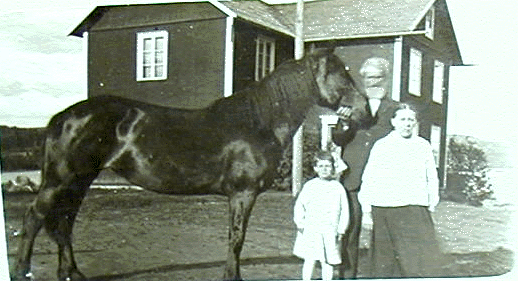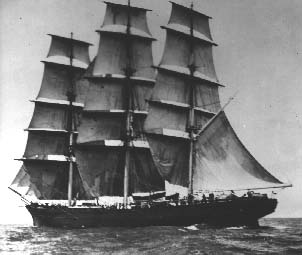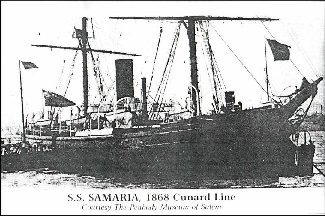
A typical Swedish farming family around 1850.
| My Family History | Return to Beginning |
Chapter 1: An Overview of Swedish Emigration

A typical Swedish farming family around 1850.
In Sweden there had always been a shortage of good land to farm. It was estimated that over 40% of Swedish soil was unproductive. This situation was made worse by an increase in population due in large part to the sharp fall in infant mortality from 21% in 1750 to 15% in 1850. The situation grew worse in the 1850s when Sweden suffered a succession of poor harvests. Unemployment grew and wages fell. This led to a increase in the numbers of people wishing to emigrate. Most of these were bankrupted farmers and out of work agricultural labourers. Only about a quarter of all Swedish emigrants came from towns and cities.
At the end of the 1860s, Sweden was struck by the last of a series of severe hunger catastrophes. The agriculture which was still only partially modernized had been struggling with difficult times. Now came a series of crop failures. 1867 thus became "the wet year" of rotting grain, 1868 became the "dry year" of burned fields, and 1869 became "the severe year" of epidemics and begging children. Sixty thousand people left Sweden during these three "starvation years". As an additional enticement, the establishment of the Homestead Act in 1862, also made it possible for immigrants to purchase land inexpensively from the United States federal government. The Act allowed anyone to file for a quarter-section of free land (160 acres). The land was yours at the end of five years if you had built a house on it, dug a well, broken (plowed) 10 acres, fenced a specified amount, and actually lived there. It was the beginning of the mass emigration which, with short intervals, was to continue up to World War I.

The Cutty Sark, one of the most famous 3-masted ships, first launched in 1869.


The SS Nevada, first launched March 18, 1865, in service until 1875; The SS Samaria, first launched July 4, 1868, scrapped in 1902.
The Swedish mass emigration would not have been possible without the Swedish railroads and the organized passenger traffic over the Atlantic. At this time no Swedish line carried passengers directly from Gothenburg to New York. The Swedes therefore had to use British or German ships. The emigrant route started with the train ride to the big port of Gothenburg, where a service like the British Wilson Line brought the emigrants to Hull in England. A train took them across the country to Liverpool or Glasgow. From there the Inman Line or some other company's ships sailed them to New York. The whole voyage Gothenburg-New York need not take more than three weeks in 1870.
Organizations based in New York such as the American Emigrant Company and the Columbia Emigration Company, placed advertisements in newspapers encouraging people to settle in the United States. These companies bought and sold land and also arranged loans. Agents from these companies also visited Swedish villages and county fairs where they gave talk on the advantages of emigrating to the United States. Swedish immigrants often went to America in ships carrying cargoes of iron to New York. These ships provided cheap passage and would charge only about $12 per person for a trip that usually took about seven weeks. Swedish emigration to the United States was well organized. At New York Harbour the ship was likely to be met by a representative of the Bethel Ship Mission, an organization which helped arrange people to travel west. A report in the New York Times in July, 1851, described immigrants carrying Swedish and American flags, while marching in military fashion to the railroad station.
For most immigrants New York was just the half-way point. In the early days the journey continued by paddle steamer up the Hudson River to Albany. Before the railroads were built the Erie Canal, completed in 1825, served as the link between the Hudson River and the Great Lakes. From Buffalo the emigrants were taken by paddle steamer over the Lakes to Chicago, Milwaukee or Duluth. The last part of the 1-3 month long journey was spent on horse carts or walking through the bush. This itinerary was, of course, completely changed by the railroads, which from the 1850s brought the emigrants straight to Chicago. Modern communications made the overland route to the homestead region relatively simple from the beginning of the Swedish mass emigration.
During the period 1820 and 1920 1.4 million Swedes emigrated to the United States. Compare this to Sweden's population at the time: 5.5 million. Roughly one fifth of all Swedes had their homes in America! Only Germany, Ireland, Italy, Austria-Hungary, Russia and England had higher-rates of immigration, and in proportion to the population of their home countries, only the British Isles and Norway surpassed Sweden in the number of immigrants. Minnesota was a popular place to settle and there are over 400 place names of Scandinavian origin in the state. By 1890, there were 100,000 Swedish born immigrants living in Minnesota.
A survey carried out in 1890 revealled that one in four Swedes in the United States were engaged in farming. It was estimated that by the 20th century they owned over 12,000,000 acres in the United States. This was a much higher figure that most other immigrant groups. However, large numbers lived in cities and by 1900 there were 150,000 first or second generation Swedes living in Chicago. This was a larger figure than any other town or city in Sweden except Stockholm. (It is an estimate that there were as many Americans of Swedish descent at the end of the twentieth century as there were inhabitants in Sweden, or a little more than eight million. Minnesota still claimed the highest percentage of its population as Swedish-Americans at 13%.)
"The Swedes are generally described as even-tempered, serious-minded individualists. They have a strong sense of property ownership and a deep religious sense. The Swedes are noted for their adaptability to American conditions, for their ability and willingness to work hard, and for their marvelous physical stamina. The percentage of home ownership is high among them. Swedes also have an unsurpassed devotion to education, and send their children to school; the rate of illiteracy among them is extremely low. Like other Scandinavians, the Swede has little difficulty in adjusting himself to the American democratic system of government, for he comes from a country in which he has already learned the technique of popular elections." - Carl Wittke, We Who Built America (1939)
Thanks to the Lutheran Church the rate of illiteracy had always been relatively low in Sweden. The Elementary School Act of 1842 almost erased illiteracy among the younger generation.
Virtually all the Swedes who arrived in the United States were members of the Lutheran Church. Swedes were legally born into the State Church and could only leave it by taking formal action. It is therefore not surprising that early settlers in the United States soon began building Lutheran churches.
"The question whether immigration shall be encouraged or restricted, and whether naturalization shall be made more difficult or not, must be considered both from the political and from an industrial point of view; and in each case it is necessary to glance back and see what have been the character, the conduct, and the political leaning of the immigrant, and what he has done to develop and enrich our country."
"If we look at the political side first, and, as our space is limited, we will go back to 1860, calling attention, however, to the fact that up to that time, no matter from what cause, the immigration had been almost entirely to the Northern and free States, and not to the slave States. These, when carefully examined in connection with election returns, will show that but for the assistance of the immigrant the election of Abraham Lincoln as president of the United States would have been an impossibility, and the nineteenth century would never have seen the great free republic we see, and the shadow of millions of slaves would today darken and curse the continent."
"The Scandinavians have always, nearly to a man, voted the Republican ticket. The Germans, likewise, were nearly always Republicans. In fact, the States having either a large Scandinavian or a large German population have been distinguished as the banner Republican States. Notably is this true of Iowa, Wisconsin, Minnesota, and Michigan, which has a large Scandinavian population; and of Illinois, Ohio and Pennsylvania, which have a very large German population." - John Peter Altgeld, Forum Magazine (February, 1890)
Go to Chapter 2: Swedish Andersson to American Skoglund